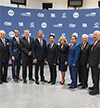Regional Report: Slow But Steady Economic Growth in New England States
Jobs are coming back slowly in New England, with aerospace/defense, bioscience, and fulfillment centers taking the lead.
Directory 2015
Jobs are coming back slowly. Massachusetts remains the only state in the region that has regained all the jobs it lost in the Great Recession. Vermont and New Hampshire are fairly close to pre-recession employment levels. In July the overall unemployment rate for New England was 6.2 percent. Vermont is one of the lowest unemployment states in the nation — its unemployment rate stood at 4.4 percent, well below the national average of 5.9 percent. Connecticut is also making good progress — it gained 11,500 jobs in September and recorded an unemployment rate of 6.4 percent, its lowest point since 2008. Maine’s unemployment registered 5.8 percent in July 2014, a rate not seen since August 2008.
Biomedicine Stays Strong
Overall, economic performance across New England has been uneven, depending on the industry and the area. Hiring has remained fairly solid in financial services, retail trade, healthcare, biomedicine, hospitality, and manufacturing. In fact, NBT Bank, an upstate New York commercial bank, recently opened a regional headquarters in Portland, Maine — the first national commercial bank to expand into Maine since 2005. And information technology segments — especially software development, data analytics, and cloud computing — have been especially robust, with some revenues growing as much as 20 percent from a year ago.
Biomedicine has remained strong, especially in Massachusetts. Biotechnology and medical device R&D and manufacturing have driven job growth in the Boston-Cambridge-Quincy metropolitan statistical area (MSA). Boston is a great place to be a start-up — so far this year, 16 biotech initial public offerings (IPOs) have been announced in the city. Johnson and Johnson is fostering R&D partnerships with six Boston-area life-sciences companies. One of these — Cambridge biotech startup Navitor Pharmaceuticals — launched in June with $23.5 million in funding from investors.
Another major player in New England — Alexion Pharmaceuticals of Cheshire, Connecticut — has undertaken a multinational, placebo-controlled clinical trial to see if its popular drug Soliris® can prevent complications that can arise after kidney transplants. Soliris®, approved for treating two rare blood and kidney disorders, generated $1.55 billion in sales in 2013.
Aerospace and Defense
New England states receive almost 10 percent of all U.S. defense and homeland security contracts — making this industry a major contributor to the regional economy. For example, the defense industry in Rhode Island supports nearly 33,000 jobs and contributes about $3.7 billion to the state economy. A key employer is General Dynamics Electric Boat Quonset Point facility, which builds nuclear submarines for the U.S. Navy. In April 2014, the Navy awarded a 17.6 billion contract to General Dynamics to build 10 more Virginia-class attack submarines over the next five years.
Safran Aerospace Composites recently opened a composites manufacturing plant in Rochester, New Hampshire, joining more than 300 other companies that work in aerospace and defense in the state. Safran Aerospace builds aircraft propulsion systems, rocket engines, and other aircraft equipment. The new plant is expected to employ up to 500 people by 2020.
In another announcement, United Technologies Corp. (UTC) will invest up to $500 million to expand its aerospace research, development, and manufacturing facilities over the next five years in Connecticut. During that same time period, UTC expects to invest up to an additional $4 billion in research and other capital expenditures in the state.
“Connecticut will remain central to our aerospace research and be the headquarters of Pratt & Whitney and Sikorsky for years to come,” says J. Michael McQuade, UTC’s senior vice president of Science & Technology. “We will continue to perform cutting-edge research and development in Connecticut that provides exciting new opportunities for top engineering and science graduates in our state.”
Logistics and Distribution
As consumer confidence increases, so do retail sales. Thanks to online purchasing, retail companies are cutting back on stocking inventory in new brick-and-mortar stores and instead are focusing on building fulfillment centers.
“Companies like Dollar Tree and Amazon have already built, or are building, fulfillment centers of one-million-plus square feet in Connecticut in response to the evolution of consumer purchasing behavior,” says Erron Smith, program manager for Real Estate at the Connecticut Economic Resource Center (CERC) in Rocky Hill. “I’ve experienced an increase in requests from site selection consultants and corporate real estate executives inquiring about available industrial-zoned acreage suitable for the development of these types of facilities — anywhere from 300,000 to one million square feet and above for the purposes of being within a day’s proximity of their consumer base.”
Amazon.com has built fulfillment centers across the country, including two in New England: one in Nashua, New Hampshire, and the newest center in Windsor, Connecticut, which will employ 300 workers. In December 2013, Coast to Coast Fulfillment, a third-party logistics provider, completed a 29,000-square-foot expansion of its order-processing center in West Greenwich, Rhode Island. The company now has about 82,000 square feet of warehouse and office space. The center will handle the staging for all outbound shipments.
“With this additional space, we will have many more pick lines operating at the same time, processing hundreds of products destined for several different chain stores simultaneously,” says Client Services Manager Randy Lundquist. “Also, now that we are an FDA-registered facility, we can process over-the-counter (OTC) drug and food supplement orders.”
Meeting Workforce Needs
Despite all the positive news, one of the biggest challenges for companies emerging from the recession is finding enough qualified workers for their expanded production needs. This is especially true for advanced manufacturing. A complicating issue is out-migration — more people are leaving parts of New England than are coming in. This makes it even more important for states to design workforce development programs that create opportunities for good-paying jobs that will be attractive to younger workers.
For example, to ensure that Rhode Island’s defense industry has all the skilled workers it needs, the state has initiated several training programs for high-demand jobs like welding. In addition, urged by M. Teresa Paiva-Weed, a member of the Rhode Island State Senate, voters supported a $125 million bond referendum to renovate the engineering school at the University of Rhode Island.
In nearby New Hampshire, U.S. Senator Jeanne Shaheen has been active in supporting partnerships between businesses and two-year colleges to customize job-training efforts, including a statewide advanced manufacturing job training program at the community college level.
“Advanced manufacturing firms are creating high-paying jobs that help us maintain our technological edge, but their success also depends on having access to a highly skilled workforce,” says Shaheen.
And in September 2014, Connecticut’s community colleges were awarded $15 million by the U.S. Department of Labor for the Connecticut Advanced Manufacturing Initiative (CAMI) grant, which will expand the colleges’ nationally acclaimed Advanced Manufacturing Centers’ industry-driven job training model. Among the colleges to benefit from this are Quinebaug Valley Community College (QVCC), which will receive $1.22 million to expand the capacity of its Manufacturing Machine Technology certificate program; and Three Rivers Community College (TRCC), which will receive $1.28 million to develop and deliver a Metal Fabrication Certificate program.
Project Announcements
Baltimore Fabrication Expands York County, Pennsylvania, Manufacturing Operations
07/25/2025
Mueller Streamline Expands Wynne, Arkansas, Manufacturing Operations
07/25/2025
Hive Plastics Plans Iron County, Utah, Manufacturing Operations
07/25/2025
Sigma Stretch Film of Georgia Plans Columbus, Georgia, Operations
07/24/2025
Turkish-Based Kervan USA Expands Lehigh Valley, Pennsylvania, Operations
07/24/2025
Germany-Based Butting Plans Loxley, Alabama, Production Operations
07/24/2025
Most Read
-
20th Annual Area Development Gold and Silver Shovel Awards
Q2 2025
-
In Focus: AI Is Changing Incentives Math
Q2 2025
-
Optimizing Your Rail-Served Transportation Network: Strategy Before Steel
Q2 2025
-
How to Choose the Right Site for Your Factory in 2025’s Volatile Landscape
Q2 2025
-
From Silicon to Server: Mapping the Data Center Supply Chain
Q2 2025
-
Tariffs, Talent, and U.S. Expansion
Q3 2025
-
First Person: David Robey, Co-CEO of QTS Data Centers
Q2 2025



